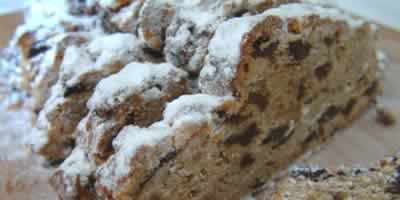Stollen

What is Stollen?
Stollen is a bread-like cake traditionally made in Germany, usually eaten during the Christmas season as Weihnachtsstollen or Christstollen. Stollen (originally Striezel) was created in Dresden in around 1450, and the most famous Stollen is still the Dresdner Stollen, sold, among other places, at the local Striezelmarkt Christmas market.
The old name Striezel was from strüzel or stroczel, "awaken" (Old Prussian: troskeilis), which came to mean "loaf of bread". The shape of the cake was originally meant to represent the baby Jesus wrapped in swaddling clothes. However, the Stollen reminded Erzgebirge miners of the entrance to a mine tunnel, which is the literal meaning of Stollen, and they renamed it.
When Stollen was first baked, the ingredients were very different. The Advent season was a time of fasting, and bakers were not allowed to use butter, only oil, so the cake was tasteless and hard. In 1647, Prince Elector Ernst and his brother Duke Albrecht decided to remedy this by writing to the then Pope, Pope Innocent X. They explained that Saxon bakers needed to use butter as oil was so expensive and hard to come by, and had to be made from turnips, which was unhealthy. The Pope granted the use of butter without having to pay a fine - but only for the Prince-Elector and his family and household. In 1691 others were also permitted to use butter, but with the condition of having to pay annually 1/20th of a gold Gulden to support the building of the Freiberg Cathedral. The ban on butter was removed when Saxony became Protestant.
Today the cake is available in many parts of the world. The true Dresden Stollen, however, is produced in the city and distinguished by a special seal depicting the city's famous king, August the Strong. This "official" Stollen is produced by only 150 bakers.
Over the centuries the cake changed from being a simple, fairly tasteless "bread" to a sweeter cake with richer ingredients, although the traditional Stollen is today still not as sweet as the copies made around the world.
Portions of this article is licensed under the GNU Free Documentation License. It uses material from the Wikipedia article "Stollen".
Lebkuchen
Lebkuchen are traditional German Christmas cookies similar to gingerbread, which were probably invented by Medieval monks in Franconia, Germany in the 13th century. Lebkuchen bakers were recorded as early as 1296 in Ulm, and 1395 in Nuremberg, but today, the most famous Lebkuchen come from Nuremberg, from where they are exported all over the world.
Lebkuchen range in taste from spicy to sweet and come in a variety of shapes with round being the most common. The ingredients usually include honey, spices and nuts, almonds or candied fruit. Salt of Hartshorn and Potash are often used for raising the dough. The Lebkuchen dough is often placed on a thin wafer base called Oblate. This was an idea of the monks who used communion wafers to prevent the dough from sticking.
The forerunner of today's Lebkuchen was called 'honey cake' and its history can be traced back to the Egyptians, the Greek and the Romans. They believed honey, the only widely available very sweet food, was a gift of the gods and had magical and healing powers. Honey cakes were also worn as a talisman in battle or as protection against evil spirits. Teutonic peoples used honey cakes for the same purpose especially around the winter solstice, which might be the reason Lebkuchen became associated with Christmas.
Portions of this article is licensed under the GNU Free Documentation License. It uses material from the Wikipedia article "Lebkuchen".

